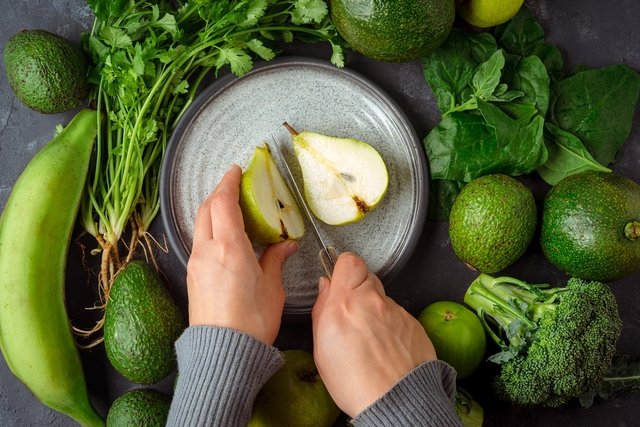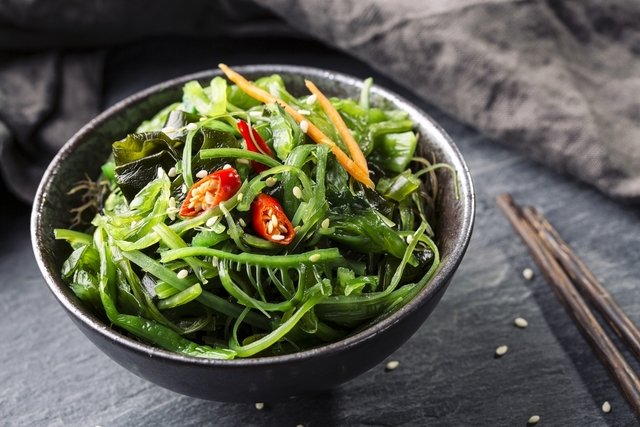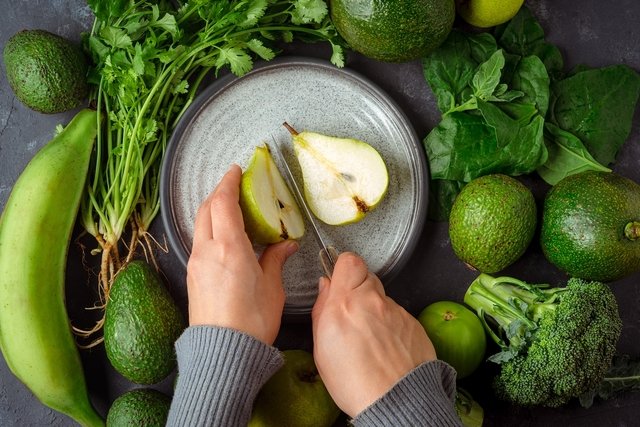Chlorophyll is a green pigment found in algae and many vegetables and fruits, such as kale, spinach and kiwi, and has anti-inflammatory and antioxidant properties, in addition to having an erythropoietic function, favoring the increase of red blood cells in the blood, helping to combat anemia. .
Because it can neutralize excess free radicals and prevent inflammation in the body, chlorophyll is a functional compound that helps prevent various health problems, such as cancer, diabetes, heart attack and high blood pressure.
In addition to being present in foods, chlorophyll is also found in supplements in the form of drinks or tablets, which are sold in health food stores and pharmacies. However, chlorophyll is contraindicated for some people and should therefore be consumed under the guidance of a doctor or nutritionist.

Chlorophyll has antioxidant, antihypertensive, erythropoietic and anti-inflammatory properties and can be used to:
1. Lower “bad” LDL cholesterol
Because it is rich in antioxidants, such as porphyrin and chlorophyllin, chlorophyll inhibits the absorption of fat from food in the intestine, in addition to facilitating the elimination of fat through feces, promoting a reduction in “bad” cholesterol levels, LDL, in the blood.
Chlorophyll also helps maintain good elasticity in the arteries and prevent the formation of fatty plaques in the blood, preventing diseases such as atherosclerosis, heart attack and high blood pressure.
2. Help you lose weight
Consuming foods that contain chlorophyll and are also rich in fiber, such as asparagus, bertalha, green cabbage, avocado and kiwi, helps to prolong satiety, contributing to weight loss. Discover more fiber-rich foods that help you lose weight.
3. Prevent premature aging
Chlorophyll has antioxidant properties, helping to neutralize excess free radicals responsible for skin damage. In this way, the pigment protects skin cells, preventing sagging and wrinkles. See other ways to combat sagging.
Because it has anti-inflammatory action, chlorophyll also prevents premature aging, as it combats inflammation caused by advanced glycation agents (AGEs), which are compounds generated by the consumption of processed foods, rich in sugar and fat and that cause sagging skin. .
4. Prevent and combat diabetes
Because it is present in foods that are rich in fiber, such as seaweed, broccoli and spinach, chlorophyll helps control insulin and blood sugar levels, preventing and combating diabetes. Discover other foods that help prevent diabetes.
Furthermore, the antioxidants present in chlorophyll help reduce free radicals in the body, preventing damage to cells that produce insulin, thus preventing diabetes.
5. Help in the treatment of anemia
By stimulating the production of red blood cells, the blood cells that are responsible for transporting oxygen in the body, chlorophyll helps in the prevention and treatment of anemia. See other foods that help treat anemia.
Chlorophyll is also present in foods that contain iron and vitamin C and, therefore, consuming the natural form of the pigment increases iron intake and absorption, combating anemia.
6. Prevent cancer
Chlorophyll contributes to the fight against free radicals, which in excess are toxic and can cause damage to healthy cells in the body, favoring the emergence of cancer. Therefore, consuming foods or supplements containing chlorophyll helps prevent some types of cancer, such as skin, breast, ovarian or colon cancer.
Consuming chlorophyll daily can also reduce the levels of aflatoxin in the body, a substance produced by fungi in foods such as peanuts and corn, which favors the development of liver cancer. In this way, chlorophyll also helps prevent liver cancer.
7. Detoxify the liver
As it is a potent antioxidant, chlorophyll can be used in the form of foods or supplements to protect and improve liver functions.
Furthermore, chlorophyll also helps detoxify the liver, as it promotes the elimination of toxic metals, such as mercury, through feces and urine.
See with our nutritionist how to prepare a detox juice to detoxify the liver:
How to use
In addition to a daily diet rich in green vegetables and fruits, such as kiwi, spinach, seaweed, peas and arugula, another way to use chlorophyll is through supplementation, where the recommended intake is normally tablets containing between 100 and 300 mg. of chlorophyll up to 3 times a day.
Furthermore, it is possible to find pure chlorophyll in drinks, where the usual recommendation is to ingest 15 drops of chlorophyll diluted in water or another drink, 1 to 4 times a day.
However, as the amount of supplementation varies according to each person’s age, sex and nutritional needs, it is important that chlorophyll consumption is always guided and monitored by a doctor or nutritionist.
Side effects
Ingesting chlorophyll in recommended amounts can cause some side effects in some people, such as diarrhea, gastric pain or discomfort or changes in the color of feces, which turn green.
It is important to remember that consuming chlorophyll can also increase the chances of spots appearing on the skin caused by exposure to the sun, and it is important to use sunscreen while using the supplement.
Who should avoid
Chlorophyll supplements are not recommended for children, pregnant women or women who are breastfeeding, as there are no studies that prove the safety of using the supplement in these situations.
Chlorophyll supplements should also not be consumed by those using anticoagulant medications, as the pigment can increase or decrease the effect of the medications.
In addition, chlorophyll supplements should also be avoided when using medications that increase the skin’s sensitivity to sunlight, such as antibiotics, pain medications and acne medications, to avoid burns.
Recipes with chlorophyll
Chlorophyll can be consumed using foods rich in the pigment, in the form of juices, smoothies or salads.
1. Juice rich in chlorophyll
Ingredients:
- Juice of ½ lemon;
- 2 cabbage leaves;
- 2 green lettuce leaves;
- ½ medium cucumber;
- ½ glass of water;
- 2 fresh mint leaves;
- 1 teaspoon of honey.
Preparation mode:
Wash the cabbage leaves, lettuce, cucumber and mint well and drain well. Place all ingredients in the blender and blend until smooth. Refrigerate and serve chilled.
2. Seaweed salad with lettuce and basil

Ingredients:
- ½ green lettuce;
- ½ purple lettuce;
- 200 g of arugula;
- 2 ripe tomatoes;
- 150 g of dried nori or wakame seaweed;
- 8 basil leaves;
- Drops of lemon juice;
- 3 spoons of soy sauce.
Preparation mode:
Wash the tomatoes, lettuce leaves, arugula and basil well and let them drain. Cut the tomatoes into slices and transfer to a platter. Add the lettuce leaves, arugula, basil and seaweed to the dish. Season with soy sauce and lemon drops, mixing well and serve.
3. Chlorophyll vitamin with banana
Ingredients:
- 200 ml of cow’s milk or vegetable milk (rice, soy or coconut);
- ½ cup of chlorophyll pulp tea (already ready);
- 1 banana media;
- 2 ice cubes;
- Lemon drops to taste.
Preparation mode:
Chop the banana into slices and place in the blender. Add the other ingredients to the blender, beat well until it becomes a homogeneous drink and serve.

Sign up for our newsletter and stay up to date with exclusive news
that can transform your routine!
Warning: Undefined array key "title" in /home/storelat/public_html/wp-content/plugins/link-whisper-premium/templates/frontend/related-posts.php on line 12
Warning: Undefined array key "title_tag" in /home/storelat/public_html/wp-content/plugins/link-whisper-premium/templates/frontend/related-posts.php on line 13




